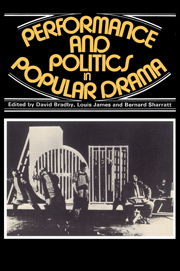 Performance and Politics in Popular Drama
Performance and Politics in Popular Drama Book contents
- Frontmatter
- Contents
- List of contributors
- Preface
- Acknowledgements
- PART ONE Spectacle, performance and audience in nineteenth-century theatre
- PART TWO Politics and performance in twentieth-century drama and film
- Introduction
- Meyerhold and Eisenstein
- Erwin Piscator's 1927 production of Hoppla, We're Alive
- Prolet Buehne: agit-prop in America
- Workers' theatre 1926–36
- The October Group and theatre under the Front Populaire
- Only the stars survive: disaster movies in the seventies
- PART THREE Problems and prospects
- Appendix: Tempo, Tempo
- Select bibliography
- General index
- Index of titles of plays, films, sketches
- Index of theatres, theatre companies and groups
Introduction
Published online by Cambridge University Press: 08 March 2010
- Frontmatter
- Contents
- List of contributors
- Preface
- Acknowledgements
- PART ONE Spectacle, performance and audience in nineteenth-century theatre
- PART TWO Politics and performance in twentieth-century drama and film
- Introduction
- Meyerhold and Eisenstein
- Erwin Piscator's 1927 production of Hoppla, We're Alive
- Prolet Buehne: agit-prop in America
- Workers' theatre 1926–36
- The October Group and theatre under the Front Populaire
- Only the stars survive: disaster movies in the seventies
- PART THREE Problems and prospects
- Appendix: Tempo, Tempo
- Select bibliography
- General index
- Index of titles of plays, films, sketches
- Index of theatres, theatre companies and groups
Summary
The first part of this book demonstrated that nineteenth-century popular theatre forms were a great deal more varied and more vital than is often thought. Far from offering nothing but escapism, the theatre of the period was able to speak to a popular audience about the things that affected it in ways that seemed urgent and relevant. Moreover, this theatre was sufficiently flexible to allow for the inclusion of all forms of popular entertainment, some of which, like equestrian drama, were not obviously associated with social or political themes. The strength of many of these theatre forms, especially of melodrama, lay in their ability to elaborate a complex system of visual signs, thus creating a theatre language that was more than the mere words of the texts. If these are facts that critics are just beginning to discover about the last century's theatre, they correspond to ideas that have long been clear to writers trying to produce popular theatre today, as will be seen from the conference discussions given on pp. 297—314 below.
In the years following the Russian Revolution, Meyerhold and Eisenstein adopted a wide range of nineteenth-century theatre forms in their experimental work towards a new kind of drama. Nick WorralPs paper shows their vigorous search for a new and enriched sign system that would enable them to speak to a popular audience not merely in verbal argument, but in powerful visual images as well.
- Type
- Chapter
- Information
- Performance and Politics in Popular DramaAspects of Popular Entertainment in Theatre, Film and Television, 1800–1976, pp. 167 - 172Publisher: Cambridge University PressPrint publication year: 1980


